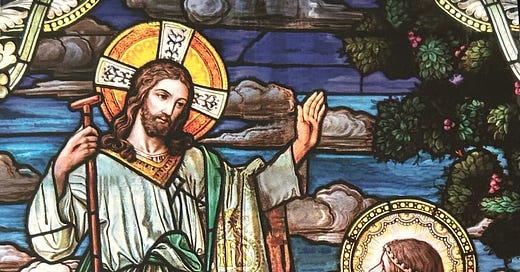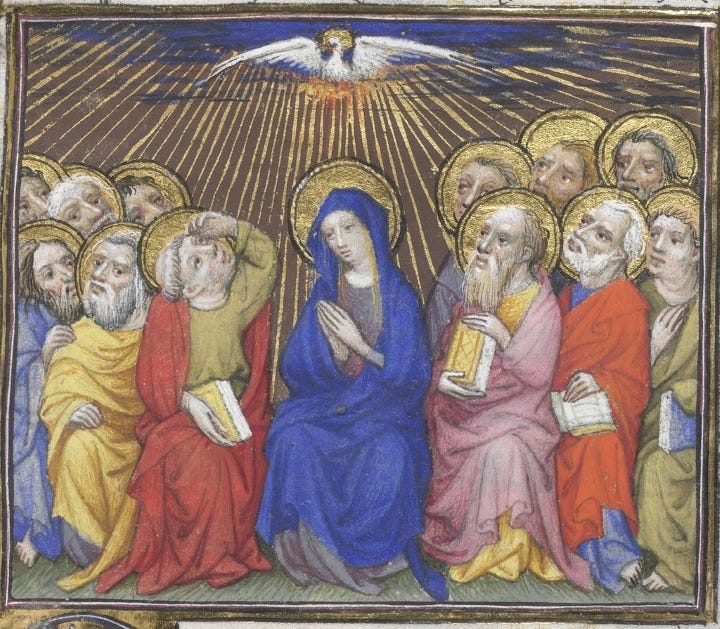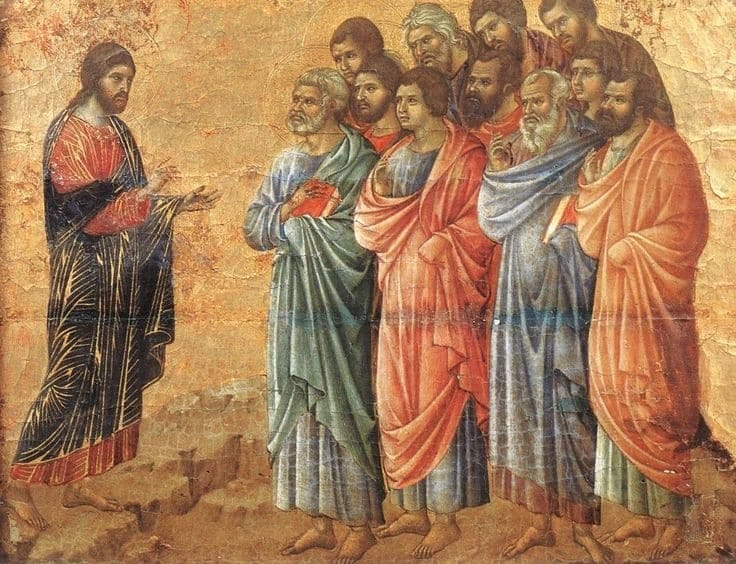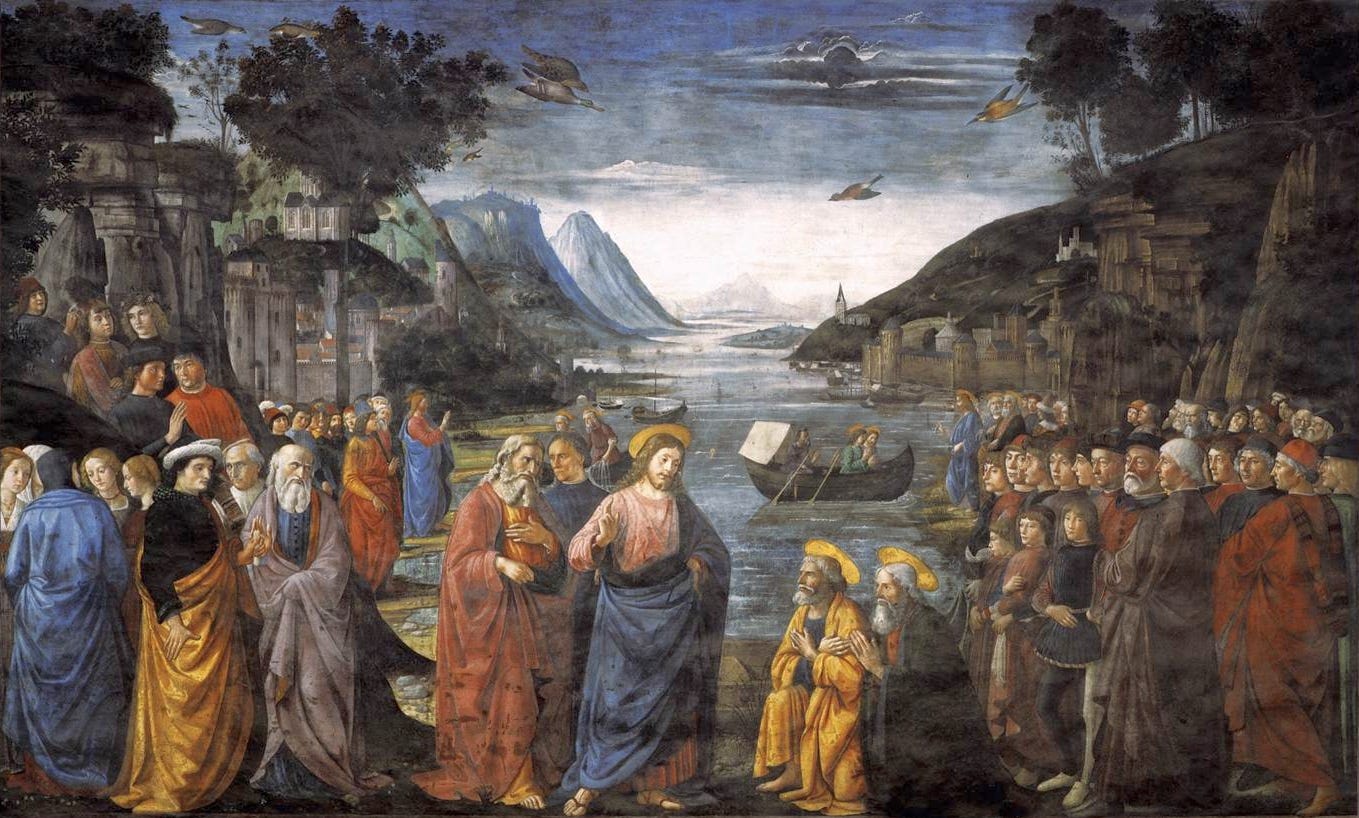In Acts 1:3, we learn that Jesus spent forty days with the apostles after His resurrection, “speaking [to them] about the Kingdom of God.” Although we’re never directly told what Jesus taught His disciples during this time, I believe the rest of Acts bears witness to the overall content of our Lord’s teaching.
The Sacraments After the Forty Days
Consider that, prior to the resurrection, there’s only one recorded instance of the apostles performing baptisms (Jn 4:1-2). However, after their forty day lesson about the Kingdom, they started baptizing people en masse, even baptizing three thousand believers in a single day (Acts 2:41). Nor was this the only sacred rite the apostles began to perform. After Jesus’ post-resurrection teaching, the apostles heard confessions (Acts 19:18), appointed successors (Acts 1:20-25), held a council (Acts 15:6), gave canonical rulings (Acts 15:22-29), and began performing a ritual laying on of hands that’s not directly spoken about in the Gospels, and this ritual itself took two forms. One was an ordination to the Church’s hierarchy (Acts 6:1-6; 13:2-3 cf. 1:20-26; 1 Tim 4:14; 2 Tim 1:6), and the other was a rite of initiation alongside baptism (Acts 8:17-19; 9:17; 19:5-6 cf. Heb 6:2). It’s also in this post-resurrection era when, for the first time, the apostles themselves celebrated the Lord’s Supper, Holy Mass (Acts 2:42), and made sure to do this regularly “on the first day of the week” (Acts 20:7).
Despite it not being explicitly stated, I believe it’s rather clear what Jesus taught His apostles during those forty days after His resurrection: how to perform the sacraments and govern the Church. Jesus taught the apostles how to properly baptize, confirm, absolve sins, appoint and ordain successors, hold councils, and celebrate the Mass. This is why the apostles started doing all of this immediately after our Lord ascended into heaven and sent down the Holy Spirit. As Christ Himself foretold, “I still have many things to say to you, but you cannot bear them now. When the Spirit of truth comes, he will guide you into all truth” (Jn 16:12-13).
The Sacraments in the Resurrection Accounts
Indeed, the Gospel accounts of the resurrection themselves attest to the fact that much of Jesus’ post-resurrection teaching centered around the liturgy and the sacraments. In Matthew 28:19-20 and Mark 16:15-16, for example, the risen Lord instructs His disciples on baptism, making sure they understand the purpose and necessity of this sacrament. The former text even contains the only biblical mention of the baptismal formula, “In the name of the Father and of the Son and of the Holy Spirit” (Matt 28:19). This implies that the proper administration of the sacraments was one of Jesus’ chief concerns after rising from the dead.
St. Luke’s resurrection account has a similar sacramental emphasis because in it Jesus set the pattern for all Christian liturgies. The risen Lord appeared to two of His disciples on the road to Emmaus, interpreted the Scriptures for them, and then was made “known to them in the breaking of the bread” (Lk 24:32-35). This is the liturgy of the Word being followed by the liturgy of the Eucharist. After His resurrection, the Lord wanted us to know that the sacred words we read during the liturgy, which all bear witness to Him (Lk 24:44), can only be understood when we partake of the Holy Eucharist, “the breaking of the bread,” where we truly come to “know” Him.
When it comes to St. John’s accounts of the resurrection, I’ve extensively documented the sacramental themes present therein elsewhere.1 By way of summary, John makes it clear that St. Peter is the new covenant’s high priest, and he portrays the Lord’s tomb as the Holy of Holies. This makes the fact that St. John “outran Peter and reached the tomb first… but he did not go in” (Jn 20:4-5) sacramentally significant. Peter is the new covenant’s chief shepherd, the high priest, and John represents the rest of the Church. John waiting for Peter to enter the Holy of Holies before entering himself on Easter morning reveals that we do indeed depend on the ministerial priesthood for the sacraments, most especially the chief priest, Peter. When Christians sacramentally gather around the Lord’s tomb on the first day of the week, we also need Peter, the pope, to go before us in order to participate in the resurrection. As the priest says at Mass, “we offer you [these gifts] firstly for your holy Catholic Church. Be pleased to grant her peace, to guard, unite and govern her throughout the whole world, together with your servant N. our Pope.”
John’s resurrection accounts also have other, even more explicit references to the sacraments. While Matthew 16:19 and 18:18 foretold that the apostles would receive the authority to absolve sins, it’s only John 20:22-23 that tells us about them actually receiving this sacramental authority after the Lord’s resurrection. John 21 further shows the risen Lord appointing St. Peter as the new covenant’s chief shepherd, and giving him the pastoral command to “feed my sheep” with the sacraments. Indeed, just as the fish miracle in Luke 5:1-11 was an enacted parable that symbolized what it meant for Peter to be a “fisher of men,” so is the fish miracle in John 21:1-14 an enacted parable that shows what it means for Peter to be the chief shepherd. The apostles and their successors may be able to successfully catch a net full of fish, but that’s not enough. In order to bring these fish to our Lord’s Eucharistic table of bread, the apostles need Peter to act on their behalf (Jn 21:11 cf. 21:7-8), lest the net be torn through schism (Jn 21:11 cf. Lk 5:6). Like the Synoptics, John is emphatic that Jesus taught His apostles about the sacraments after His resurrection.
The Significance of the Forty Days
Throughout Scripture, the number forty tends to signify periods of transition and transformation. In Genesis 7:12, for example, we learn that the world was reborn through the Great Flood for “forty days and forty nights.” The people of Israel were likewise “reborn” during the forty years they spent in the wilderness (Deut 29:5), a period of time they needed to spiritually break free from the bondage of Egypt and transition into “a kingdom of priests and a holy nation” (Ex 19:6). This itself was foreshadowed by Moses spending “forty days and forty nights” on Mount Sinai to receive the tablets of the law (Ex 34:28), the law that was supposed to transform Israel into a people who could safely dwell in the presence of God. Even after Israel’s exile in the wilderness was complete, an additional forty days was required to spy out the land of Canaan (Num 13:25), the final preparation before their conquest of the land.
Something similar is going on with the apostles’ forty day lesson about the Kingdom of God. Consider that Moses, the leader of Israel, was uniquely prepared by God for a transition to the old covenant over the course of forty days, after which the whole nation was prepared and transformed over the course of forty years; and this was a time demarcated by special signs and wonders. In the same way, the apostles, the leaders of the new Israel, were uniquely prepared by Jesus for a transition to the new covenant over the course of forty days, after which the Church herself was prepared and transformed over the course of forty years (AD 30-70), a time that was likewise known for miracles wrought by the Holy Spirit.
The old conquest began with God miraculously destroying the city of Jericho forty years after Israel’s exodus from Egypt (Josh 6:20-21), and the new conquest began in AD 70 with God miraculously destroying the apostate city of Jerusalem, forty years after the beginning of our Lord’s ministry. Just as both Moses and Israel were trained on how they would cultically relate to God in the promised land during their respective forty day or year periods, so too were the apostles trained on how they would cultically and sacramentally relate to Jesus during their forty days of encountering His resurrected presence. Indeed, they were taught how to conquer the world, not with the sword of the old covenant, but with the Spirit of the new covenant, the Spirit who is present in and through the Church’s sacraments.
Seraphim Hamilton further argues that the apostles’ forty day lesson very well could be the origin of many of the “unwritten traditions” that the church fathers often spoke about.2 Many of these traditions, e.g. the sign of the cross, image veneration, invocation of saints, prayers for the dead, are indeed liturgical and cultic, and so it’s not unlikely that they originate from this time. For example, consider a refrain that’s ubiquitous across both eastern and western Christian liturgies: “peace be with you… and with your spirit.” This seems to be taken from Jesus’ words to the apostles after His resurrection, “Peace be with you” (Lk 24:35; Jn 20:21, 26), making it plausible that this was one of the liturgical traditions that Jesus taught His disciples before ascending into heaven. If this is the case, then Acts 2:42 stating that the members of the new covenant devoted themselves to “the apostles’ teaching” and “the prayers,” truly could have these unwritten liturgical traditions in mind.
All of this to say, after His Passion, Death, and Resurrection, our sweetest Lord Jesus Christ wanted to ensure that we had access to the saving benefits of this great redemption through the sacraments. Truly, who is so great a God as our God?
See my article, “What Eastern Orthodox Apologists Miss About the Papacy,” VI. The Eucharistic Meaning of St. Peter’s Primacy.
Seraphim Hamilton, “The Liturgical Transmission of Tradition in the Church.”








Et cum spiritu tuo...
John Chrysostom says that this liturgical formula is a relic of a bygone era, when the Spirit still motivated the elder-men presiding over the people of the Lord in sacred assembly...
“[I]n truth the Church was a heaven then [in apostolic times], the Spirit governing all things, and moving each one of the rulers and making him inspired. But now we retain only the symbols of those gifts. For now also we speak two or three, and in turn, and when one is silent, another begins. But these are only signs and memorials of those things. Wherefore when we begin to speak, the people respond, “with your Spirit,” indicating that of old they thus used to speak, not of their own wisdom, but moved by the Spirit. But not so now: (I speak of my own case so far.) But the present Church is like a woman who has fallen from her former prosperous days, and in many respects retains the symbols only of that ancient prosperity; displaying indeed the repositories and caskets of her golden ornaments, but bereft of her wealth: such an one does the present Church resemble” (Homily XXXVI on First Corinthians).